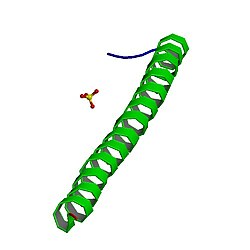Apc, wnt signaling pathway regulator
APC, WNT signaling pathway regulator is a protein that in humans is encoded by the APC gene.[4]
Function[edit]
This gene encodes a tumor suppressor protein that acts as an antagonist of the Wnt signaling pathway. It is also involved in other processes including cell migration and adhesion, transcriptional activation, and apoptosis. Defects in this gene cause familial adenomatous polyposis (FAP), an autosomal dominant pre-malignant disease that usually progresses to malignancy. Disease-associated mutations tend to be clustered in a small region designated the mutation cluster region (MCR) and result in a truncated protein product. [provided by RefSeq, Jul 2008].
References[edit]
- ^ a b c GRCm38: Ensembl release 89: ENSMUSG00000005871 – Ensembl, May 2017
- ^ "Human PubMed Reference:". National Center for Biotechnology Information, U.S. National Library of Medicine.
- ^ "Mouse PubMed Reference:". National Center for Biotechnology Information, U.S. National Library of Medicine.
- ^ "Entrez Gene: APC, WNT signaling pathway regulator". Retrieved 2018-05-22.
Further reading[edit]
- Stern HS, Viertelhausen S, Hunter AG, O'Rourke K, Cappelli M, Perras H, Serfas K, Blumenthall A, Dewar D, Baumann E, Lagarde AE (February 2001). "APC I1307K increases risk of transition from polyp to colorectal carcinoma in Ashkenazi Jews". Gastroenterology. 120 (2): 392–400. doi:10.1053/gast.2001.21170. PMID 11159880.
- Slattery ML, Samowitz W, Ballard L, Schaffer D, Leppert M, Potter JD (February 2001). "A molecular variant of the APC gene at codon 1822: its association with diet, lifestyle, and risk of colon cancer". Cancer Res. 61 (3): 1000–4. PMID 11221825.
- Bertario L, Russo A, Sala P, Eboli M, Giarola M, D'amico F, Gismondi V, Varesco L, Pierotti MA, Radice P (March 2001). "Genotype and phenotype factors as determinants of desmoid tumors in patients with familial adenomatous polyposis". Int. J. Cancer. 95 (2): 102–7. doi:10.1002/1097-0215(20010320)95:2<102::aid-ijc1018>3.0.co;2-8. PMID 11241320. S2CID 2201237.
- Silverberg MS, Clelland C, Murphy JE, Steinhart AH, McLeod RS, Greenberg GR, Cohen Z, Siminovitch KA (March 2001). "Carrier rate of APC I1307K is not increased in inflammatory bowel disease patients of Ashkenazi Jewish origin". Hum. Genet. 108 (3): 205–10. doi:10.1007/s004390100474. PMID 11354631. S2CID 12831161.
- Bahar AY, Taylor PJ, Andrews L, Proos A, Burnett L, Tucker K, Friedlander M, Buckley MF (July 2001). "The frequency of founder mutations in the BRCA1, BRCA2, and APC genes in Australian Ashkenazi Jews: implications for the generality of U.S. population data". Cancer. 92 (2): 440–5. doi:10.1002/1097-0142(20010715)92:2<440::aid-cncr1340>3.0.co;2-o. PMID 11466700.
- Michie S, Bobrow M, Marteau TM (August 2001). "Predictive genetic testing in children and adults: a study of emotional impact". J. Med. Genet. 38 (8): 519–26. doi:10.1136/jmg.38.8.519. PMC 1734924. PMID 11483640.
- Houlston RS, Tomlinson IP (August 2001). "Polymorphisms and colorectal tumor risk". Gastroenterology. 121 (2): 282–301. doi:10.1053/gast.2001.26265. PMID 11487538.
- Guldenschuh I, Hurlimann R, Muller A, Ammann R, Mullhaupt B, Dobbie Z, Zala GF, Flury R, Seelentag W, Roth J, Meyenberger C, Fried M, Hoppeler T, Spigelman AD, Scott RJ (August 2001). "Relationship between APC genotype, polyp distribution, and oral sulindac treatment in the colon and rectum of patients with familial adenomatous polyposis". Dis. Colon Rectum. 44 (8): 1090–7, discussion 1097–9. doi:10.1007/bf02234627. PMID 11535846. S2CID 41605505.
- Ruiz-Ponte C, Vega A, Conde R, Barros F, Carracedo A (October 2001). "The Asp1822Val variant of the APC gene is a common polymorphism without clinical implications". J. Med. Genet. 38 (10): 33e–33. doi:10.1136/jmg.38.10.e33. PMC 1734740. PMID 11584047.
This article incorporates text from the United States National Library of Medicine, which is in the public domain.




